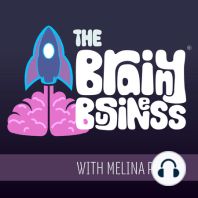51 min listen

172. Why We Like the Things We Like, with Prince Ghuman, coauthor of Blindsight
FromThe Brainy Business | Understanding the Psychology of Why People Buy | Behavioral Economics
172. Why We Like the Things We Like, with Prince Ghuman, coauthor of Blindsight
FromThe Brainy Business | Understanding the Psychology of Why People Buy | Behavioral Economics
ratings:
Length:
44 minutes
Released:
Oct 1, 2021
Format:
Podcast episode
Description
Back on episode 160, I was joined by Dr. Matt Johnson to discuss his book Blindsight and the work he and his counterpart were doing at Pop Neuro. Today, that counterpart, Prince Ghuman, is here to expand on that conversation and discuss some more amazing work. One of the things I loved in the book, and that Prince and I really expanded on today, is why we like the things we like. Some of what we discuss today tie back to my recent interview with Dr. Troy Campbell in episode 169 on the Science of Cool. It was a much-loved episode and I expect similar high praise from today’s conversation! Show Notes: [00:06] In today’s episode I’m excited to introduce you to Prince Ghuman, coauthor of Blindsight. [02:57] Prince Ghuman shares about himself, his background, and how he got into the world of behavioral science and marketing. He is an author and professor. [05:11] Prince and Matt are founders of Pop Neuro where they teach marketers how to ethically apply neuroscience to marketing. [06:07] One of the things lacking in the marketing curriculum is a heavier emphasis on neuroscience and psych. [07:05] If we are marketers, we are fundamentally students of human behavior and human psychology. [09:37] The principle piece is as important if not more important than the traditional neuroscience imaging techniques. [11:38] He would love for there to be one person on each marketing team that specializes in neuromarketing principles because, at the end of the day, marketers want to create good marketing and good brand experiences. Consumers also want to be charmed by brands, products, and experiences. [13:31] Cross-functional teams are the answer. Having one neuromarketer on every marketing team is the bare minimum. Every marketing position should understand behavioral science. [16:03] The next operating system of marketing is more deeply scientific. [17:06] The more we philosophically touch and experience something, the more we are likely to prefer it. [17:50] We like things that are different because we like novelty, and we like things that are similar because we like the safety of similar things. If something is too new it hurts adoption. If something is too safe it hurts adoption. It needs to be somewhere between new and safe. [18:48] Sandwiching something new in between two familiar things helps bump up the likability. [19:48] Early adopters have a higher acceptance of an imbalance of new and safe when it is tilted towards new. Late adopters are tilted towards safety. [22:43] When Oreo brings out new cookies, it gets them back on your radar even if you don’t try the new types. [23:27] Listener Question! Attention is based on the brain's statistical learning tendency. Our brains are also taking into account and picking up on patterns. [26:04] Unpredictability gives you a bigger hit of dopamine. Unpredictability hits the reward center a lot harder. The brain’s pattern-seeking behavior primarily happens behind the scenes. It just drives a lot of what we do. [28:27] It is called the “pursuit of happiness” because it is the pursuit that gives us the most amount of happiness, not the achievement of happiness. [30:10] Unpredictability works to increase engagement. [32:59] Today’s new thing that you hate is replacing something that was new once (and that you hated then). [35:25] As much as we want to point a finger at companies that are using digital products to model behavior, we also have to look at ourselves. Until we decide to kick our addiction to “free” it is going to be really hard to kick our addiction to Instagram. [37:48] For marketers, the challenge is to understand neuroscience and psychology throughout the entire marketing process so we can create better products, brands, and experiences. [39:01] The answer to bad marketing isn’t no marketing. It is better marketing. Neuroscience is the way to do it. [41:46] Melina shares her closing thoughts. [43:54] Melina’s award-winning first book, What Your Customer Wants and
Released:
Oct 1, 2021
Format:
Podcast episode
Titles in the series (100)
1. Unlocking The Secrets Of The Brain: That is what behavioral economics is all about. And it is what I am so passionate about. by The Brainy Business | Understanding the Psychology of Why People Buy | Behavioral Economics